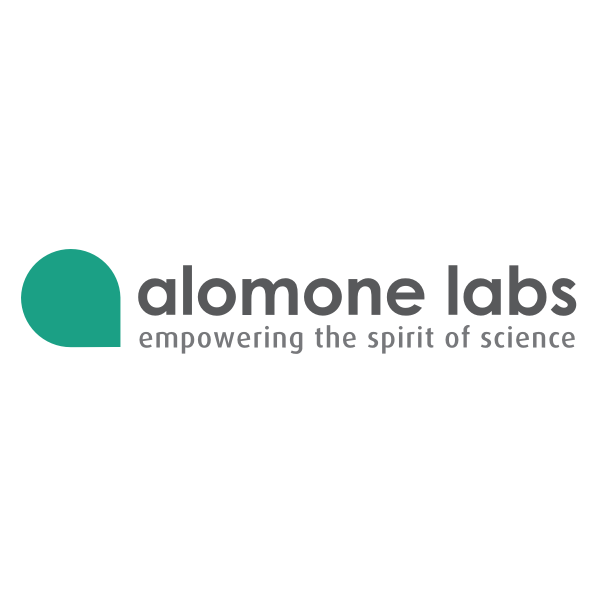

品牌: Alomone
 下载产品说明书
下载产品说明书 用小程序,查商品更便捷
用小程序,查商品更便捷



 收藏
收藏
 对比
对比 咨询
咨询纯度:
Affinity purified on immobilized antigen.
Affinity purified on immobilized antigen.
反应种属:
H, M, R
H, M, R
产品介绍
产品信息
纯化方式
Affinity purified on immobilized antigen.

宿主
Rabbit

免疫原
Peptide (C)RLEPNSIDPENITE, corresponding to amino acid residues 57-70 of rat TrkB (Accession Q63604). Extracellular domain.

简单描述
A Rabbit Polyclonal Antibody to TrkB

商品描述
Anti-TrkB (extracellular) Antibody (#ANT-019) is a highly specific antibody directed against an epitope of the rat protein. The antibody can be used in western blot, immunohistochemistry, indirect flow cytometry, and live cell imaging applications. It has been designed to recognize TrkB from rat, mouse, and human samples.

同种型
Rabbit IgG.

纯度
Affinity purified on immobilized antigen.

形式
Lyophilized

组成成分
酪氨酸激酶受体B抗体;磷酸盐缓冲液;防腐剂(0.05%叠氮化钠溶液)

基因
NTRK2

应用
实验应用
ICC, IF, IFC, IHC, LCI, WB

反应种属
H, M, R

背景
别名
Neurotrophic tyrosine kinase receptor type 2, NTRK2, BDNF/NT-3 growth factors receptor

背景
BDNF and NT-4 belong to the neurotrophin family which also includes NGF and NT-3. These neurotrophins bind two groups of receptors. The p75NTR receptor is common to all four neurotrophins and is a member of the tumor necrosis factor receptor family. The tropomyosin-related kinase (Trk) receptors are receptor tyrosine kinases (RTKs) and three receptors form this family: TrkA, TrkB, and TrkC1.
As mentioned above, the p75NTR receptor binds to all neurotrophins with similar affinities while the Trk receptors are the ones to display the selectivity for the neurotrophins. TrkA is activated by NGF binding, TrkB by that of BDNF and NT-4, while TrkC is stimulated by the binding of NT-3 1.
All three Trk receptors are highly expressed in the mammalian brain in very distinct regions and are also expressed in the peripheral nervous system2-4. Cholinergic neurons in the basal forebrain exclusively express TrkA, while TrkB and TrkC are highly expressed in the hippocampus. Motor and sensory neurons in the peripheral nervous system express Trk receptors. Interestingly, Trk receptors are not essential for development, but knockout mice die shortly after birth. Indeed, TrkB-deficient mice demonstrate a significant decrease in motor neurons and synaptogenesis1.
Trk receptors have many motifs in the extracellular region, including cell-adhesion domains, three tandem leucine rich motifs flanked by two clusters of cysteines. In the membrane proximal region of the receptor there are also two immunoglobulin-like domains5. The binding of neurotrophins to Trk receptors promotes receptor dimerization resulting in kinase activation. Activated Trk receptors then phosphorylate a cascade of signaling molecules including the Ras/ERK, PI3K/Akt pathways and PLC-g1. Activated Trk receptors also create internal docking sites for other signaling adaptor proteins to bind to5. Splice variants of TrkA, TrkB and TrkC have been observed. These splice isoforms are mainly affected in the tyrosine kinase domain of the receptor lying in the cytoplasm. Endocytosis is an important signaling trait of Trk receptors.
Following neurotrophin binding to the Trk receptor, the receptor complex is then internalized via endocytosis in order to terminate signaling. However, in the axonal compartment of neurons the internalization process of the neurotrophin complexed to the receptor is part of the signaling process and is important for activating transcription processes in the nucleus6,7.
As mentioned above, the p75NTR receptor binds to all neurotrophins with similar affinities while the Trk receptors are the ones to display the selectivity for the neurotrophins. TrkA is activated by NGF binding, TrkB by that of BDNF and NT-4, while TrkC is stimulated by the binding of NT-3 1.
All three Trk receptors are highly expressed in the mammalian brain in very distinct regions and are also expressed in the peripheral nervous system2-4. Cholinergic neurons in the basal forebrain exclusively express TrkA, while TrkB and TrkC are highly expressed in the hippocampus. Motor and sensory neurons in the peripheral nervous system express Trk receptors. Interestingly, Trk receptors are not essential for development, but knockout mice die shortly after birth. Indeed, TrkB-deficient mice demonstrate a significant decrease in motor neurons and synaptogenesis1.
Trk receptors have many motifs in the extracellular region, including cell-adhesion domains, three tandem leucine rich motifs flanked by two clusters of cysteines. In the membrane proximal region of the receptor there are also two immunoglobulin-like domains5. The binding of neurotrophins to Trk receptors promotes receptor dimerization resulting in kinase activation. Activated Trk receptors then phosphorylate a cascade of signaling molecules including the Ras/ERK, PI3K/Akt pathways and PLC-g1. Activated Trk receptors also create internal docking sites for other signaling adaptor proteins to bind to5. Splice variants of TrkA, TrkB and TrkC have been observed. These splice isoforms are mainly affected in the tyrosine kinase domain of the receptor lying in the cytoplasm. Endocytosis is an important signaling trait of Trk receptors.
Following neurotrophin binding to the Trk receptor, the receptor complex is then internalized via endocytosis in order to terminate signaling. However, in the axonal compartment of neurons the internalization process of the neurotrophin complexed to the receptor is part of the signaling process and is important for activating transcription processes in the nucleus6,7.

制备和贮存
溶解方法
25 µl, 50 µl or 0.2 ml double distilled water (DDW), depending on the sample size.

保存方式
The antibody ships as a lyophilized powder at room temperature. Upon arrival, it should be stored at -20°C.
数据库链接
Entrez-Gene ID
25054

UniProt ID
Q63604

研究资源识别码
AB_10918025.

声明 :本官网所有报价均为常温或者蓝冰运输价格,如有产品需要干冰运输,需另外加收干冰运输费。







 危险品化学品经营许可证(不带存储) 许可证编号:沪(杨)应急管危经许[2022]202944(QY)
危险品化学品经营许可证(不带存储) 许可证编号:沪(杨)应急管危经许[2022]202944(QY)  营业执照(三证合一)
营业执照(三证合一)